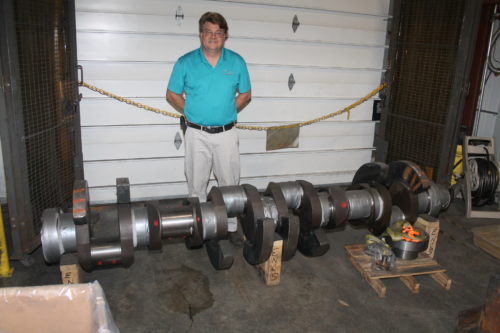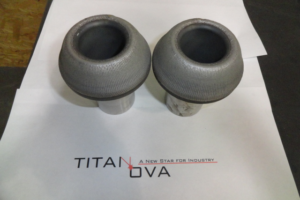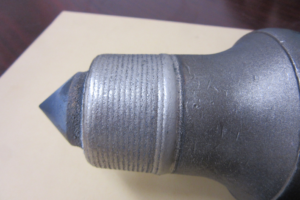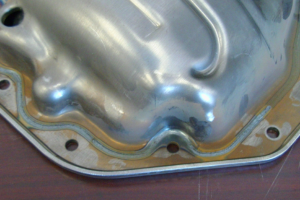Heat treating
Mining equipment components – Seal Carriers
Titanova developed a cost-saving laser heat treat process for large diameter seal carriers for off-road mining trucks. These seal carries require that the seal surface be surface hardened to decrease abrasive wear. The previous process utilized the subcritical gas nitriding which a diffusion process that is lower temperature [less distortion] as compared to other heat treating process therefore is was the process of choice for these large diameter rings. However, the yield from this process was very low due to egging of the rings requiring an inordinate amount of rework and labor to get the rings to fit during production assemble.
Titanova developed a laser heat treating process to case harden this wide seal surface.
The result was a significant reduction in egging distortion on the order of 7X – 10x. And this completed solved the assembly headaches.
M1 Abrams Tank Turret Ring Race
M1 Abrams Tank has a 50 caliber machine gun on a turret ring race components.
The tank was designed in the 1970’s with the first production run in late 1970’s. The turret ring system is comprised of three component inner and outer bearing race and a spur gear ring. The surface requiring hardness are the ball bearing race surfaces. The current MIL spec, circa 1972, specifies a flame and induction case hardening process. However, due the tolerances required and the small aspect ratio of thickness to diameter, this process had to be done on forged parts with only the surface to be case hardened partially exposed. This was necessary in order to have enough thermal mass quenching the surface and in addition allow enough material for subsequent removal to compensate for the large distortion. This is a very expensive process. The customer came to Titanova to solve the huge and expensive problem due to the fact that they could not deliver to the specification. They could not obtain the necessary hardness and dimensional tolerances with this old process, and this was only realized after part had so much invested in it.
Titanova was able to heat treat the completely machined rings achieving higher case harnesses, more uniformity, and lower distortion as compared to the existing process, thus saving the customer and the US taxpayers a tremendous amount of money and time.
Tools – Perfect Fit
One of the most familiar examples of laser heat treating is tools. Channellock, Inc. specifically uses laser heat treat in which the Titanova principals help design process and build the diode laser heat treat system.
The greatest benefit is that the laser allows for the case hardening of the a selective surface, in this case the plier jaw teeth or cutting surface , while maintaining the toughness of the core.
Cladding for Remanufacturing
Titanova’s diode laser cladding is a new weld repair process that can be used to restore critical worn surfaces of metal parts. Typical critical surfaces are the bearing journals and seal surfaces for hydraulic shafts. Titanova diode laser cladding technology has much less heat and dilution that lead to excessive distortion as compared to traditional arc welding, such as MIG and TIG over-lay processes. In addition the laser clad are much thinner and much more uniform therefore significantly reducing per and post machining costs and issues.
Wind turbine shafts
Titanova is certified to laser clad wind turbine main shafts. Unlike thermal spray repair, the laser cladding is not limited to the 0.015” built up therefore many more shaft can be reclaimed. In fact Titanova has clad as much as 5 mm per side to recover damaged shafts. Our standard capacity is 15000 lbs but we have repaired shafts as large at 25000 lbs.
Locomotive Crank shafts
Low distortion Laser cladding opens up the opportunity to fix distortion and heat sensitive parts. One of the most difficult items to remanufacturing using a welding process is a crank shaft. Due to the critical run out tolerances required by crank shafts distortion must be minimized. Is addition, most cranks are further enhanced by a combination of heat treating processes to enhance fatigue resistance. Traditional welding process are not candidates due to excess heat and distortion.
Hardfacing
Mining bit holders
Mining equipment is exposed to the most extreme environments with respect to abrasion wear. Millions of dollars’ worth of repairs and maintenance is spent on worn out components. Titanova laser hardfacing gives the mining industry a unique capability to cost effectively selectively hardface mining consumables using Tungsten carbide [WC] overlays, thus prolonging tool life. Mining bit holders are an example of a such an application where excessive wear of the bit holder collet leads to premature failure. Titanova hard facing solution solved this problem.
Automotive housing pans
It is well known throughout the industries that laser welding offers high speed and high quality welds. Titanova uniquely understand the relationship because high speed does not necessarily mean high quality. One application brings this point to the fore front. Achieving high speed low heat hermetic welds for nested automotive cover pans.
Titanova developed a unique beam intensity profile to achieve high welding speeds = low heat, but at the same time achieve a hermetic [leak free weld].
Laser Welding of Automotive laminated Steels
Titanova was challenged to laser weld studs onto pans stamped from Noiseless Steel or quite steel, an acoustically constructed product specifically designed to reduce noise and vibration. The Noiseless Steel is a sandwiched steel panel consisting of two sheets of metal with a visco-elastic inner layer that results in a metal/plastic/metal (MPM) panel. This is Very very! problematic when it comes to welding. Titanova utilized it unique knowledge of laser welding to design a process to achieve high quality hermetic welds. This is great example of the control of power of lasers for welding.











